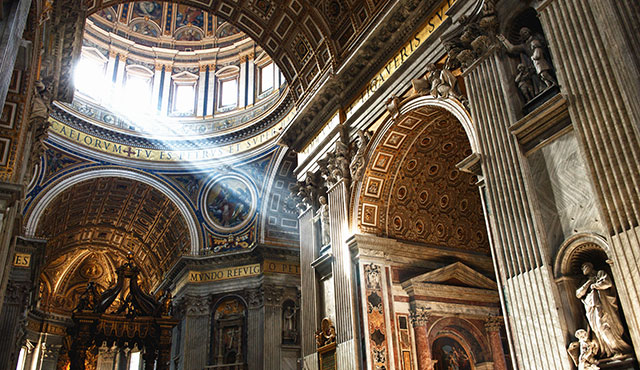The word “rock” refers to anything foundational, anything unmoving or unyielding during a challenge. In this context, a rock is a dependable mainstay, an anchor in a storm.
St. Peter was – and forever remains – a rock of the Catholic Church. Jesus had confidence in him when He renamed Simon, a fisherman from Bethsaida, Peter; the Greek equivalent, “Petrus,” means “rock.”
Appointed by Jesus to lead the Apostles, Peter is considered to be the father of the Church. In following Christ’s wishes, Peter nurtured Catholicism the same way a loving father nurtures a newborn. His life and legacy will forever be at the very foundation of the Church.
“We believe that Peter is the first pope,” says Msgr. Stephen Doktorczyk, Vicar General of the Diocese of Orange. “Jesus gave Peter the keys to the Kingdom of Heaven.”
Peter was called to be a disciple during the early days of Christ’s ministry. Along with his brother Andrew, another disciple, he was influenced by the preaching of repentance by John the Baptist. Peter and the other disciples followed Jesus throughout the region. Returning to fishing for a brief time, he and Andrew became two of Jesus’ permanent disciples, after Jesus said, “Come ye after me, and I will make you to be fishers of men.”
Peter soon stood out as the Apostle with the strongest faith and love of Jesus. The Lord promised that Peter would eventually be the leader of His flock. Despite his faith, he wasn’t perfect.
“The Bible points out Peter’s humanity,” says Msgr. Doktorczyk. “He wasn’t saintly all the time. It would have been easier for the Gospel writers to ‘sanitize’ the lives of those appearing in Sacred Scripture, but they included their flaws. This should strengthen our faith in the reliability of Scripture. … On three separate occasions, Peter denied knowing Jesus. But Jesus gave him an opportunity to renounce his denial.”
In John 21:15, during the Last Supper, Jesus said, “Simon, son of John, do you love Me more than these?” “Yes, Lord,” Peter answered. “You know I love you.” Jesus said, “Feed my lambs.”
Msgr. Doktorczyk notes that the reference to “these” is open to interpretation, though, he adds, “What makes sense to me is, ‘Do you love me more than you love things such as your fishing nets and other equipment?’ That is to say, ‘Are you going back to your former trade or will you continue to follow me?’”
Following his admission of denial, Peter became the perfect example of the forgiven sinner. Befitting his role as the leader of the Apostles, he was the first person to enter Christ’s tomb and declare Him the Messiah. After His Ascension, Peter designated the replacement of Judas, delivered a significant outdoor sermon to a huge crowd during Pentecost, led the efforts to assist the poor and was the first to perform miracles – such as healing the sick – in the name of Jesus.
“Peter knew that his gift of healing was through Jesus, that Jesus was performing these miracles through him,” Msgr. Doktorczyk says. “In Acts 5:15 and 16, the sick were brought out into the street hoping that the shadow of Peter would fall on them and heal them as he walked by. According to Scripture, this worked.”
As the rock of the Church, some of Peter’s miracles were downright brutal.
“There’s the story of Ananias and Sapphira, who sold their land but withheld a portion of their money to the Apostles. Followers were supposed to give all of their proceeds to the Apostles, who would distribute them to the poor. When Peter caught Ananias lying about the amount of the proceeds received from the sale, and after Ananias failed to be honest with Peter, Ananias suddenly dropped dead. When three hours later his wife visited Peter looking for her husband and recounted the same inaccurate account as Ananias, she was struck dead on the spot.”
Peter took great pains to help keep the Church unified, actions that affected Catholicism through the centuries.
“He knew that there were going to be some growing pains in the Church, and he worked on what traditions at that time should be kept. Today, the teaching, sanctifying and governing that bishops and pastors do, these are the very elements that were stressed by Peter.”
Peter was crucified in the Year 64 or 67, Msgr. Doktorczyk says. “Peter said, ‘I’m not worthy to die in the same way as my Lord.’”
So Peter’s killers turned him upside down. He was first buried in a shallow grave on Vatican Hill.
Recognizing the far-reaching influence that Peter had on the world, the Roman Emperor Constantine ordered that a basilica be constructed around Peter’s permanent place of burial.
“St. Peter’s Basilica was built on a hill, to ensure that Peter’s place of burial would be in its exact center. However, it would’ve been far easier to construct it on flat land close to the burial place,” Msgr. Doktorczyk says. “Constantine wanted to be precise to honor Peter.”
Any structure built on a hill that would last for centuries would’ve required an extremely strong foundation – which is befitting of St. Peter, the rock of the Catholic Church.

